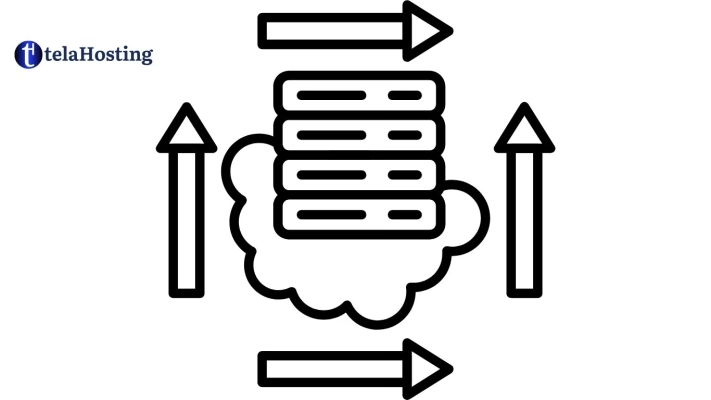
Cloud hosting is the key to ensuring your website remains fast, reliable, and scalable as it grows. As your website expands, so do its requirements. An increase in visitors, content, and traffic can strain your hosting resources. If your site is loading slowly, facing downtime, or struggling to keep pace, it may be time to explore cloud hosting for better scalability.
At telaHosting, we recognize how crucial a fast, dependable, and scalable website is, particularly for businesses, eCommerce platforms, and blogs in Nigeria. In this guide, we’ll clarify what cloud hosting is, how it enhances scalability, and how to implement it to ensure your website can grow seamlessly.
What is Cloud Hosting?

Cloud hosting is a web hosting solution that utilizes multiple interconnected servers to store and manage website data. Unlike traditional hosting, which depends on a single physical server, cloud hosting spreads resources across several virtual servers.
Think of cloud hosting like a city’s water supply system. If the city depended on just one water tank, residents would face shortages during peak demand. However, with several interconnected tanks, water flows smoothly even when demand surges.
That’s how cloud hosting operates; it distributes the workload across multiple servers, ensuring your website remains fast and responsive regardless of visitor numbers.
Why Cloud Hosting Is Ideal for Scalability
1. Automatic Resource Scaling

One of the key benefits of cloud hosting is its capability to automatically adjust resources according to real-time demand. This guarantees that your website consistently has the appropriate amount of computing power to manage traffic effectively.
How Traditional Hosting Works vs. Cloud Hosting
In traditional hosting, your website is allocated a fixed amount of resources, including CPU, RAM, storage, and bandwidth. If your site suddenly sees a spike in visitors, it might exceed its resource limits, leading to slow performance or even downtime. The only solution is to manually upgrade to a higher plan, which can be time-consuming and costly.
In contrast, cloud hosting operates on a network of interconnected servers that can dynamically allocate additional resources as needed. This means:
- Instant Scaling: If your website suddenly attracts thousands of visitors, cloud hosting automatically increases CPU power, memory, and bandwidth without any manual effort.
- No Wasted Resources: When traffic drops, unused resources are released, ensuring you don’t pay for excess capacity.
- Seamless Performance: Visitors enjoy smooth and fast loading speeds, no matter how many users are accessing your site.
Why This Matters for Your Website
- Ideal for businesses with fluctuating traffic, such as eCommerce stores during sales or blogs that go viral.
- No need to forecast future growth—your website scales automatically based on real-time demand.
- Reduces the risk of performance issues, leading to a better user experience and improved SEO rankings.
With telaHosting’s cloud hosting, you can rest easy knowing that you won’t have to deal with manual upgrades as your website will grow alongside your business effortlessly.
2. No Downtime During Traffic Spikes

For any online business, experiencing downtime is a nightmare. A website that crashes during peak traffic can lead to:
- Lost sales (especially for eCommerce sites)
- A poor customer experience (visitors may leave and not return)
- Decreased SEO rankings (Google favors sites with high uptime)
Traditional hosting relies on a single physical server, which means all traffic is managed by one machine. If traffic suddenly exceeds the server’s capacity, your website may slow down or crash. Cloud hosting resolves this problem by:
- Distributing traffic across multiple servers: If one server becomes overloaded, another automatically steps in to manage the additional load.
- Utilizing redundant backups: If one server fails, another immediately takes its place, keeping your site online.
- Implementing load balancing technology: This prevents any single server from becoming overwhelmed, ensuring smooth and stable website performance.
Why This Matters for Your Business
- Guaranteed uptime during peak hours, seasonal sales, and marketing campaigns.
- No risk of server overload, even if your site goes viral.
- Enhanced business reputation as many visitors trust websites that are consistently accessible.
With telaHosting’s cloud hosting, your website stays online 24/7, even during the busiest times.
3. Pay for What You Use (Cost-Effective Solution)

One of the main issues with traditional hosting is paying for resources that may go unused. Many website owners end up overpaying for higher-tier plans just to prevent crashes during peak traffic, even if they don’t always need that extra capacity. But with cloud hosting, you only pay for the resources your website actually uses.
How the Pay-As-You-Go Model Works
- During high traffic periods: Additional CPU, RAM, and bandwidth are automatically allocated to your hosting plan, ensuring smooth performance.
- During low traffic periods: The system automatically reduces resources, helping to lower your costs.
- No need for long-term commitments: You aren’t locked into fixed pricing, making it more affordable for businesses with fluctuating traffic.
- No need to buy expensive dedicated servers that may remain underutilized.
- Scalable pricing ensures that you pay only for what you need.
- Perfect for startups and growing businesses that want to manage costs efficiently.
At telaHosting, our cloud hosting plans allow you to maximize performance while minimizing expenses—helping you scale without breaking the bank.
4. Better Website Speed and Performance

Website speed is a critical factor for both user experience and search engine rankings. Studies show that 53% of visitors leave a website if it takes more than 3 seconds to load. This means that a slow website can cost you traffic, conversions, and even search engine rankings.
Unlike traditional hosting, where your website relies on a single physical server, cloud hosting distributes your website’s workload across multiple interconnected servers. This means that:
- If one server is busy or slow, another picks up the load, ensuring fast response times.
- Website resources (RAM, CPU, bandwidth) are dynamically adjusted to maintain optimal performance.
- Visitors are routed to the fastest available server, preventing bottlenecks and delays.
For businesses, eCommerce stores, and content-heavy websites, speed is everything. With elaHosting’s cloud hosting solutions, your website loads lightning fast, keeping visitors happy and improving overall performance.
5. Higher Security and Reliability

Security and uptime are top priorities for any website owner. Whether you’re running a small business, online store, or blog, you need protection against cyber threats and reliable uptime to keep your site running smoothly.
Cloud hosting minimizes risks by storing data across multiple servers rather than a single machine. This setup ensures:
- No Downtime: If one server fails, another takes over instantly, preventing service disruptions.
- Load Distribution: Hackers often use DDoS attacks to overwhelm websites with fake traffic. Cloud hosting spreads incoming requests across multiple servers, preventing overload.
- Regular Backups: With telaHosting’s cloud hosting, your data is automatically backed up at multiple locations, ensuring you never lose valuable information.
Cons of Cloud Hosting for Website Scalability
While cloud hosting brings fantastic scalability, performance, and reliability to the table, it does come with its own set of challenges. Before you decide to make the leap, it’s crucial to be aware of the potential downsides.
1. Higher Costs for Continuous Scaling: Cloud hosting operates on a pay-as-you-go basis, which means your costs can vary depending on how much you use it. If your website is always in need of extra resources, those expenses can add up quickly compared to the fixed pricing of traditional hosting. For businesses with steady and predictable traffic, cloud hosting might end up being pricier than they bargained for.
Solution: Establish budget limits and keep an eye on your resource usage to steer clear of any surprise costs.
2. Requires Some Technical Knowledge: Unlike shared hosting, cloud hosting often demands a bit of server management know-how, especially when it comes to setting up auto-scaling, security configurations, and custom tweaks. Beginners might find themselves needing some help or opting for managed cloud hosting services to navigate the technical side of things.
Solution: Go for a managed cloud hosting provider like TelaHosting, where the experts take care of the setup, monitoring, and maintenance for you.
3. Potential Downtime During Maintenance or Network Issues: Even though cloud hosting is known for its high availability, there can still be times when network failures or maintenance lead to temporary service interruptions. If a data center runs into trouble, your website could be impacted unless it’s set up with redundancy across multiple locations.
Solution: Choose a provider that has multiple data centers and built-in failover systems to help reduce the risk of downtime.
4. Security and Compliance Concerns: Storing data across various cloud servers can heighten your exposure to cyber threats. Certain industries, like finance and healthcare, have strict data protection regulations that can be tricky to navigate with cloud hosting.
Solution: Make sure your provider offers SSL certificates, firewalls, data encryption, and DDoS protection to keep your sensitive information safe.
5. Dependence on Internet Connectivity: Cloud hosting is all about being online. If your internet is slow or keeps dropping out, it can be a real hassle to manage your cloud server or even get into your website’s backend. For businesses located in areas with shaky internet infrastructure, making the most of cloud hosting can be quite a challenge.
Solution: Invest in high-speed internet and think about setting up a local caching system to keep your website accessible even during short outages.
How to Use Cloud Hosting for Website Scalability
Now that you see the importance of cloud hosting for scalability, let’s look at how to use it effectively.
Step 1: Choose the Right Cloud Hosting Provider
Not all cloud hosting providers deliver the same level of scalability, reliability, and security. Selecting the right provider is the crucial first step to ensuring a seamless website experience. Here’s what to consider when choosing a cloud hosting provider like telaHosting:
- Flexible Plans: Your hosting plan should allow you to adjust resources based on your website’s requirements. This way, you only pay for what you use while still having the option to scale up when necessary.
- 99.9% Uptime Guarantee: A reputable cloud hosting provider should minimize downtime. Your website should remain accessible 24/7, even during peak traffic times.
- 24/7 Expert Support: Technical issues can occur at any time. A dependable provider should offer continuous customer support to help resolve any issues.
- Strong Security Features: Your cloud hosting provider should include firewalls, DDoS protection, SSL certificates, and automatic backups to safeguard your data.
At telaHosting we offers all these features, ensuring that your website stays scalable, secure, and efficient.
Step 2: Optimize Website Performance for Cloud Hosting
After transitioning to cloud hosting, the next step is to enhance your website to ensure it loads quickly and efficiently. Even with the best hosting provider, a poorly optimized website can waste resources and hinder performance. So you can use these ways to optimize your website performance:
- Use a Content Delivery Network (CDN): A CDN distributes your website’s files across various global servers, allowing visitors from different locations to access your site more quickly. Instead of relying on a single main server, your website loads from the server closest to the user, significantly improving speed.
- Enable Caching: Caching allows your website to store copies of frequently accessed pages, which reduces the time it takes to retrieve data from the server. This can greatly enhance load times, especially for returning visitors.
- Use Lightweight Themes & Plugins: A website cluttered with heavy themes, plugins, and unnecessary scripts can slow down even the best cloud hosting. Always choose lightweight, optimized themes and limit your plugins to the essentials to enhance performance.
- Optimize Images & Media Files: Large images can hinder your site’s speed. Utilize tools like TinyPNG or WP Smush to compress images without sacrificing quality.
- Upgrade to the Latest PHP Version: If your website operates on WordPress or other CMS platforms, make sure you’re using the latest PHP version for improved security and speed.
By following these optimization steps, you’ll ensure that your cloud-hosted website performs at its best.
Step 3: Set Up Auto-Scaling Features
One of the key benefits of cloud hosting is auto-scaling, which allows your website to automatically adjust resources based on traffic levels. This keeps your website stable and efficient, even during peak traffic times. Here is how auto-scaling works:
- Automatic Resource Allocation: If your website experiences a sudden surge in traffic, cloud hosting automatically allocates more resources (CPU, RAM, bandwidth) to manage the increased load.
- Scale Down When Traffic Decreases: When your website’s traffic normalizes, cloud hosting automatically reduces resources, ensuring you only pay for what you actually use.
- No Manual Upgrades Required: Unlike traditional hosting, where you need to manually upgrade to a larger plan, cloud hosting adjusts resources dynamically without any downtime.
telaHosting’s cloud hosting features built-in auto-scaling, allowing your website to grow seamlessly.
Step 4: Monitor and Analyze Traffic Trends
To fully leverage cloud hosting, it’s essential to keep an eye on your website’s traffic patterns and resource usage. This allows you to spot trends, anticipate growth, and adjust your hosting resources as needed. You can monitor your website traffic by:
- Use Google Analytics: This tool helps you track visitor behavior, peak traffic times, bounce rates, and the duration of visits on your site.
- Use telaHosting’s Control Panel: Here, you can check real-time resource usage, including CPU, RAM, and bandwidth consumption.
- Identify Peak Hours: If you observe high traffic during certain times, you can set up your cloud hosting to automatically scale resources to meet demand.
- Upgrade Storage and Bandwidth as Needed: If your website is experiencing consistent growth, consider increasing your storage or bandwidth to ensure optimal performance.
By analyzing your traffic trends, you can make informed decisions that enhance your website’s stability and efficiency.
Step 5: Secure Your Cloud Hosting Environment
Although cloud hosting is typically more secure than traditional options, it’s important to implement additional security measures to safeguard your website from cyber threats. You can enhance cloud hosting security through:
- Using SSL Certificates: These encrypt user data and protect sensitive information from hackers. Additionally, Google tends to rank SSL-enabled sites higher in search results.
- Enabling Firewalls and Malware Protection: A web application firewall (WAF) can block harmful traffic, hacking attempts, and brute force attacks.
- Scheduling Regular Backups: Even with cloud hosting, it’s wise to maintain off-site backups to guard against accidental data loss or cyber threats.
- Using Strong Passwords & Two-Factor Authentication (2FA): Protect your hosting account and content management system (e.g., WordPress, Joomla, Drupal) with robust passwords and 2FA.
telaHosting’s cloud hosting comes with built-in security features, ensuring your website stays safe from cyber threats.
Cloud Hosting vs. Traditional Hosting (Comparison Table)
| Feature | Cloud Hosting | Traditional Hosting |
|---|---|---|
| Scalability | Instant scaling (resources adjust automatically) | Fixed resources (manual upgrades required) |
| Performance | Faster loading times with multiple servers | Slower during high traffic |
| Uptime | 99.9% uptime (failover protection) | Risk of downtime if server crashes |
| Security | Advanced security & backups | Limited security features |
| Cost | Pay only for what you use | Fixed price, even if resources are unused |
| Traffic Handling | Handles large traffic effortlessly | Can crash under high traffic |
Why Choose telaHosting for Cloud Hosting
At telaHosting, we offer scalable and high-performance cloud hosting solutions specifically designed for businesses in Nigeria.
- Affordable Pricing: You only pay for what you actually use.
- Instant Scalability: Experience no downtime during traffic spikes.
- Lightning-Fast Speed: Optimized for both SEO and user experience.
- 99.9% Uptime Guarantee: Your website remains online 24/7.
- 24/7 Customer Support: Get expert assistance whenever you need it.
Looking to scale your website with cloud hosting? Reach out to us today!
Want to know how to upgrade your hosting plan? Check this post: Upgrade Your Hosting Plan for a Growing Website’s Success
Final Thoughts
If you’re aiming for a fast, scalable, and reliable website that can grow alongside your business, cloud hosting is the ideal option. Unlike traditional hosting, it automatically adjusts resources to accommodate increased traffic without any crashes or slowdowns.
At telaHosting, we simplify and make it affordable to transition to cloud hosting. Whether you’re managing an eCommerce store, a blog, or a business website, we have the right plan for you.
Ready to elevate your website? Get cloud hosting from us today!